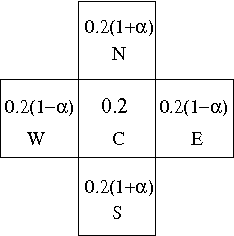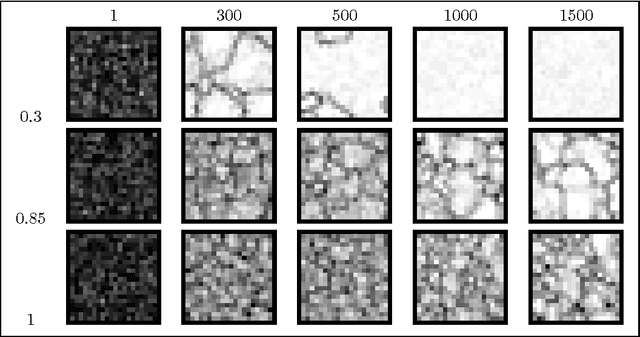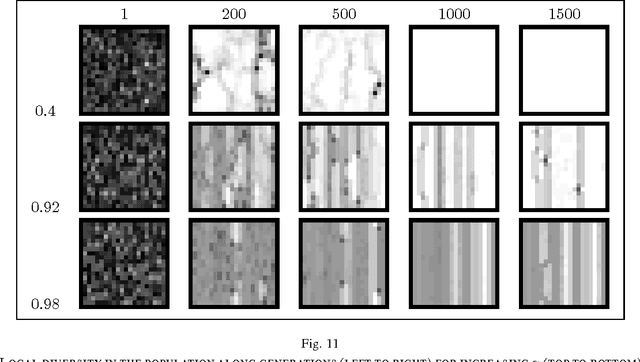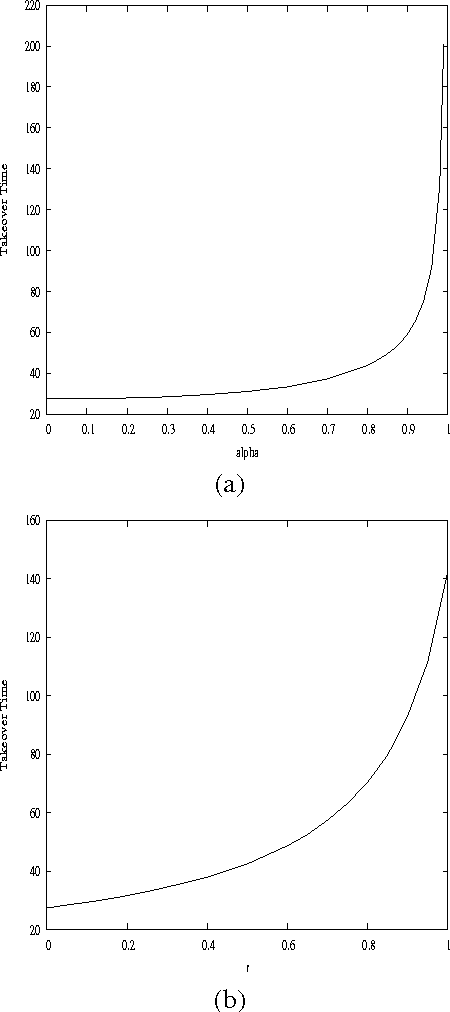Philippe Collard
ISI
NK landscapes difficulty and Negative Slope Coefficient: How Sampling Influences the Results
Jul 21, 2011



Abstract:Negative Slope Coefficient is an indicator of problem hardness that has been introduced in 2004 and that has returned promising results on a large set of problems. It is based on the concept of fitness cloud and works by partitioning the cloud into a number of bins representing as many different regions of the fitness landscape. The measure is calculated by joining the bins centroids by segments and summing all their negative slopes. In this paper, for the first time, we point out a potential problem of the Negative Slope Coefficient: we study its value for different instances of the well known NK-landscapes and we show how this indicator is dramatically influenced by the minimum number of points contained into a bin. Successively, we formally justify this behavior of the Negative Slope Coefficient and we discuss pros and cons of this measure.
Centric selection: a way to tune the exploration/exploitation trade-off
Jul 21, 2011



Abstract:In this paper, we study the exploration / exploitation trade-off in cellular genetic algorithms. We define a new selection scheme, the centric selection, which is tunable and allows controlling the selective pressure with a single parameter. The equilibrium model is used to study the influence of the centric selection on the selective pressure and a new model which takes into account problem dependent statistics and selective pressure in order to deal with the exploration / exploitation trade-off is proposed: the punctuated equilibria model. Performances on the quadratic assignment problem and NK-Landscapes put in evidence an optimal exploration / exploitation trade-off on both of the classes of problems. The punctuated equilibria model is used to explain these results.
Do not Choose Representation just Change: An Experimental Study in States based EA
May 18, 2009



Abstract:Our aim in this paper is to analyse the phenotypic effects (evolvability) of diverse coding conversion operators in an instance of the states based evolutionary algorithm (SEA). Since the representation of solutions or the selection of the best encoding during the optimization process has been proved to be very important for the efficiency of evolutionary algorithms (EAs), we will discuss a strategy of coupling more than one representation and different procedures of conversion from one coding to another during the search. Elsewhere, some EAs try to use multiple representations (SM-GA, SEA, etc.) in intention to benefit from the characteristics of each of them. In spite of those results, this paper shows that the change of the representation is also a crucial approach to take into consideration while attempting to increase the performances of such EAs. As a demonstrative example, we use a two states SEA (2-SEA) which has two identical search spaces but different coding conversion operators. The results show that the way of changing from one coding to another and not only the choice of the best representation nor the representation itself is very advantageous and must be taken into account in order to well-desing and improve EAs execution.
Deceptiveness and Neutrality - the ND family of fitness landscapes
Jan 23, 2009



Abstract:When a considerable number of mutations have no effects on fitness values, the fitness landscape is said neutral. In order to study the interplay between neutrality, which exists in many real-world applications, and performances of metaheuristics, it is useful to design landscapes which make it possible to tune precisely neutral degree distribution. Even though many neutral landscape models have already been designed, none of them are general enough to create landscapes with specific neutral degree distributions. We propose three steps to design such landscapes: first using an algorithm we construct a landscape whose distribution roughly fits the target one, then we use a simulated annealing heuristic to bring closer the two distributions and finally we affect fitness values to each neutral network. Then using this new family of fitness landscapes we are able to highlight the interplay between deceptiveness and neutrality.
On the Influence of Selection Operators on Performances in Cellular Genetic Algorithms
Apr 05, 2008



Abstract:In this paper, we study the influence of the selective pressure on the performance of cellular genetic algorithms. Cellular genetic algorithms are genetic algorithms where the population is embedded on a toroidal grid. This structure makes the propagation of the best so far individual slow down, and allows to keep in the population potentially good solutions. We present two selective pressure reducing strategies in order to slow down even more the best solution propagation. We experiment these strategies on a hard optimization problem, the quadratic assignment problem, and we show that there is a value for of the control parameter for both which gives the best performance. This optimal value does not find explanation on only the selective pressure, measured either by take over time and diversity evolution. This study makes us conclude that we need other tools than the sole selective pressure measures to explain the performances of cellular genetic algorithms.
From Cells to Islands: An unified Model of Cellular Parallel Genetic Algorithms
Mar 29, 2008



Abstract:This paper presents the Anisotropic selection scheme for cellular Genetic Algorithms (cGA). This new scheme allows to enhance diversity and to control the selective pressure which are two important issues in Genetic Algorithms, especially when trying to solve difficult optimization problems. Varying the anisotropic degree of selection allows swapping from a cellular to an island model of parallel genetic algorithm. Measures of performances and diversity have been performed on one well-known problem: the Quadratic Assignment Problem which is known to be difficult to optimize. Experiences show that, tuning the anisotropic degree, we can find the accurate trade-off between cGA and island models to optimize performances of parallel evolutionary algorithms. This trade-off can be interpreted as the suitable degree of migration among subpopulations in a parallel Genetic Algorithm.
Evolving Dynamic Change and Exchange of Genotype Encoding in Genetic Algorithms for Difficult Optimization Problems
Mar 29, 2008



Abstract:The application of genetic algorithms (GAs) to many optimization problems in organizations often results in good performance and high quality solutions. For successful and efficient use of GAs, it is not enough to simply apply simple GAs (SGAs). In addition, it is necessary to find a proper representation for the problem and to develop appropriate search operators that fit well to the properties of the genotype encoding. The representation must at least be able to encode all possible solutions of an optimization problem, and genetic operators such as crossover and mutation should be applicable to it. In this paper, serial alternation strategies between two codings are formulated in the framework of dynamic change of genotype encoding in GAs for function optimization. Likewise, a new variant of GAs for difficult optimization problems denoted {\it Split-and-Merge} GA (SM-GA) is developed using a parallel implementation of an SGA and evolving a dynamic exchange of individual representation in the context of Dual Coding concept. Numerical experiments show that the evolved SM-GA significantly outperforms an SGA with static single coding.
Neutral Fitness Landscape in the Cellular Automata Majority Problem
Mar 29, 2008



Abstract:We study in detail the fitness landscape of a difficult cellular automata computational task: the majority problem. Our results show why this problem landscape is so hard to search, and we quantify the large degree of neutrality found in various ways. We show that a particular subspace of the solution space, called the "Olympus", is where good solutions concentrate, and give measures to quantitatively characterize this subspace.
Eye-Tracking Evolutionary Algorithm to minimize user's fatigue in IEC applied to Interactive One-Max problem
Mar 21, 2008

Abstract:In this paper, we describe a new algorithm that consists in combining an eye-tracker for minimizing the fatigue of a user during the evaluation process of Interactive Evolutionary Computation. The approach is then applied to the Interactive One-Max optimization problem.
Anisotropic selection in cellular genetic algorithms
Feb 18, 2008



Abstract:In this paper we introduce a new selection scheme in cellular genetic algorithms (cGAs). Anisotropic Selection (AS) promotes diversity and allows accurate control of the selective pressure. First we compare this new scheme with the classical rectangular grid shapes solution according to the selective pressure: we can obtain the same takeover time with the two techniques although the spreading of the best individual is different. We then give experimental results that show to what extent AS promotes the emergence of niches that support low coupling and high cohesion. Finally, using a cGA with anisotropic selection on a Quadratic Assignment Problem we show the existence of an anisotropic optimal value for which the best average performance is observed. Further work will focus on the selective pressure self-adjustment ability provided by this new selection scheme.
 Add to Chrome
Add to Chrome Add to Firefox
Add to Firefox Add to Edge
Add to Edge